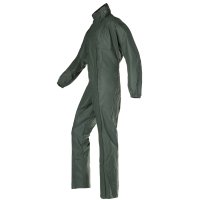WORKWEAR
Esko's apparel size guide—view and download here
Gone are the days when workwear was simply clothing that could withstand the rigours of manual labour, usually made from heavy cotton canvas with little emphasis on style and individuality. Today, workwear suppliers blend performance fabrics with function and fit, creating garments that are also great looking, safe and durable.
Protective Clothing
Protective clothing is clothing designed specifically to minimise risk where workplace hazards cannot be wholly eliminated or isolated.
Hazards requiring protective clothing include:
Under New Zealand law, businesses are required to provide necessary protective clothing to workers, free of charge. An employee may voluntarily provide their own clothing PPE, provided it meets the employer’s requirements.
Everyday items such as pants or shoes worn at work are not generally considered protective clothing. Employers don’t need to provide clothing for workers in non-hazardous situations, though many do. The garment can then be customised with a business name or logo—a walking billboard for business promotion.
Hazards requiring protective clothing include:
- Asbestos fibres
- Chemical splashes and sprays
- Biological hazards
- Extreme temperatures
- Outdoor UV rays
Under New Zealand law, businesses are required to provide necessary protective clothing to workers, free of charge. An employee may voluntarily provide their own clothing PPE, provided it meets the employer’s requirements.
Everyday items such as pants or shoes worn at work are not generally considered protective clothing. Employers don’t need to provide clothing for workers in non-hazardous situations, though many do. The garment can then be customised with a business name or logo—a walking billboard for business promotion.
Disposable Coveralls
You can reuse fabric overalls, right? So why buy disposable coveralls? Here’s a quick rundown of the advantages:
If you’re considering disposable coveralls for critical situations, for instance when dealing with infectious agents, wearers must be instructed in correct methods of removing coveralls. See Esko’s downloadable guide to donning and doffing disposable coveralls. Esko’s protective coveralls have been tested for breakthrough time of permeation to a range of chemicals, according to EN374-3.
- Disposables are a requirement when dealing with hazardous substances like asbestos
- They avoid cross-contamination from any residues
- If necessary, disposables can be incinerated
- In medical situations, there’s no need for re-sterilisation after use
- Disposables avoid laundry costs where soiling may be difficult to remove with washing, for example:
- Paint
- Oils
- Grease
- They are lightweight, breathable and comfortable, helping to avoid heat stress
- Disposables allow freedom of movement to bend and stretch
If you’re considering disposable coveralls for critical situations, for instance when dealing with infectious agents, wearers must be instructed in correct methods of removing coveralls. See Esko’s downloadable guide to donning and doffing disposable coveralls. Esko’s protective coveralls have been tested for breakthrough time of permeation to a range of chemicals, according to EN374-3.
High-Visibility Clothing (Hi-vis)
In our daily lives we see people wearing fluoro orange and fluoro yellow tops and jackets, sometimes with a darker colour at the bottom, sometimes not, sometimes with reflective with tape, sometimes not… are you confused yet?
So, what do the configurations mean?
So, what do the configurations mean?
There’s two standards in New Zealand:
- AS/NZS 1906.4.2023 for Hi-vis fabrics and tape, setting the minimum requirements for daytime wear, and retro reflective tape for night/dark conditions, and/or in garments when the wearer needs to be highly visible
- AS/NZS 4602.1.2011 setting out the design elements of garments that use the fabrics and tape specified in AS/NZS 1906.4.2023:
- D - Daylight only. The garment must have a at least 0.2m2 of fluorescent high-visibility AS/NZS 1906 compliant fabric on both front and back of the torso
- N - Night-time only. No specified high-visibility material requirement, but the garment must have a compliant amount of 50mm wide reflective tape, set out in a specified pattern
- D/N - Combines the requirements of Class D high-vis fabric with Class N requirements for the various configurations for reflective tape placement.
High-vis garments made from cotton fabric are not as bright as synthetic. Both will lose their fluorescent qualities over time. They must be regularly inspected and replaced if damaged or faded. In constant use, garments should be checked at 3 to 6-month intervals.
Sun Protective Clothing
AS/NZS 4399.2017 governs New Zealand’s ultraviolet protection factor (UPF) classifications.
The classification tells us how well the fabric blocks solar UVR (the invisible energy produced by the sun—UVA, UVB and UVC). The higher the UPF rating of the fabric, the more UVR is blocked by the fabric.
The item must cover at least a certain area of the head or body—clothing which doesn’t cover a significant area of skin should not be considered sun protective clothing even though the fabric may block UVR.
Traffic Control Clothing
The classification tells us how well the fabric blocks solar UVR (the invisible energy produced by the sun—UVA, UVB and UVC). The higher the UPF rating of the fabric, the more UVR is blocked by the fabric.
The item must cover at least a certain area of the head or body—clothing which doesn’t cover a significant area of skin should not be considered sun protective clothing even though the fabric may block UVR.
Traffic Control Clothing
NZTA (Waka Kotahi) has its own suite of requirements for garments worn by people working in temporary traffic management, recognising the high-risk factors present within the roading corridor and close proximity, or related development sites. These requirements use AS/NZS 1906.4.2023 and AS/NZS 4602.1.2011 standards as a base, then add specific details for the design of the garments. NZTA’s E06:2023 Specification for the design and manufacture of high visibility safety garments for traffic control purposes has recently (2023) replaced the previous CoPTTM Section B3.
Compliant garments will display TTMC-W23 on the label.
Compliant garments will display TTMC-W23 on the label.
The requirements apply to clothing for operations such as:
- Traffic management
- Road construction
- Road maintenance
- Roadside vegetation control
- Surveying
- Roadside line maintenance






